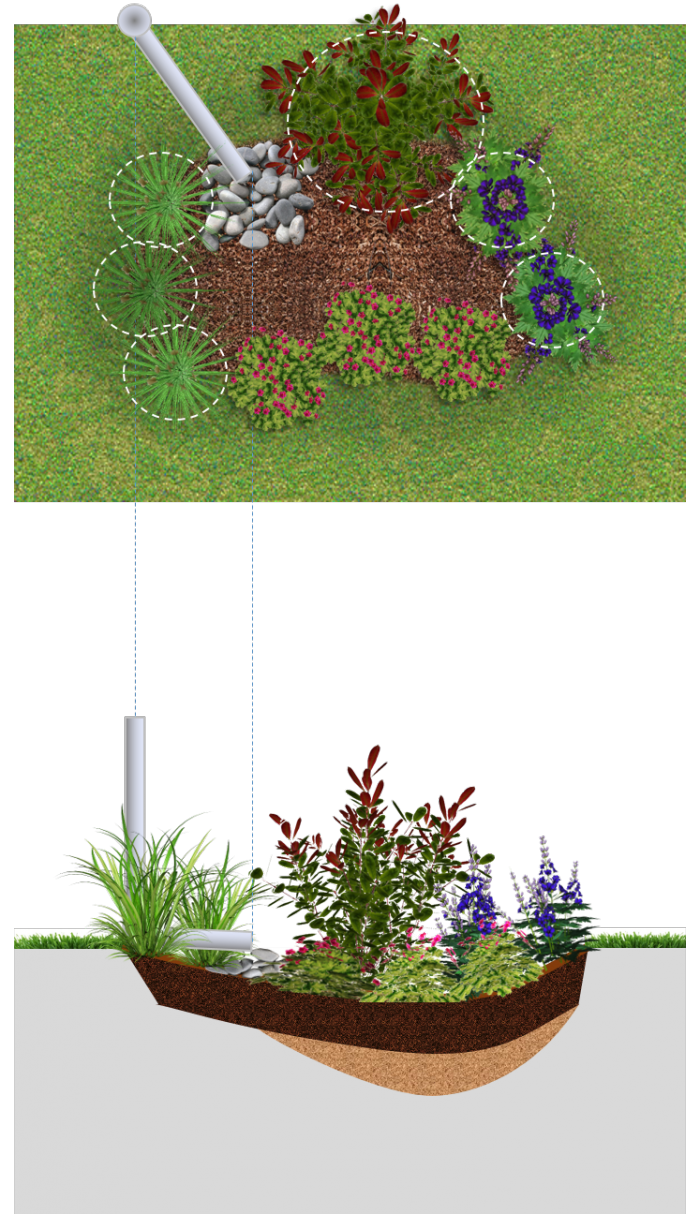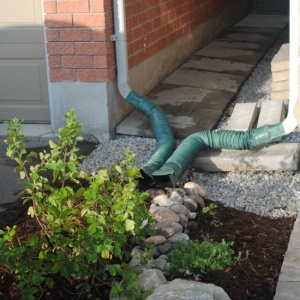Rain gardens
This article is about planted installations designed to capture surface runoff in an amended soil.
For more highly engineered systems, see Bioretention.
Overview[edit]
Rain gardens capture roof, lawn and driveway runoff from low to medium density residential lots. These can be simple gardens constructed by the homeowner as a retrofit, or they can be professionally designed into a residential development.
Rain gardens are ideal for:
- Capturing the flow from disconnected downspouts
- Community design/build projects for raising awareness about stormwater capture and functional landscapes
The fundamental components of a rain garden are:
- An amended soil mix
- Suitable planting
Additional components may include:
- A splash pad of stone to prevent the downspout flow from eroding the soil
- An overflow channel to another area of the garden
Planning Considerations[edit]
Design[edit]
Plant Selection[edit]
The design of a rain garden allows for several different planting zones.
- A variety of plant material can be selected based on the desired aesthetic, including turf grass, ornamental grasses and perennial flowers, shrubs, and trees.
- The aesthetic can range from very naturalistic to quite formal, depending on the planting plan.
- Vegetation must also be capable of tolerating prolonged wet and dry periods unless an irrigation plan is in place
- If the facility is intended to be relatively inconspicuous, then the tallest plant material should be placed into the deepest part of the rain garden.
Since rain gardens are typically smaller scale homeowner projects smaller stock plants may be considered. Smaller containers may be easier to purchase, transport, and plant, but it may take longer to have a fully vegetated garden. Plant material per Canadian Standards for Nursery Stock, Eighth Edition. Seed planting is not recommended for rain gardens. Plants should be container grown, balled and burlapped or wire basket.
Below are recommended plant sizes for planting rain garden features:
Deciduous Shrubs - 60 - 80 cm height
Coniferous Shrubs / Broadleaf Evergreens - 40 cm spread (roughly #3 or 3 gal. container)
Perennials/Grasses - 15 cm to #1 or 1 gal. container stock
Ground Cover/ Vines - 10 cm to #1 or 1 gal. container stock
Hydric Zone Criteria[edit]
| Low Zone | Often referred to as the extended detention or shoreline fringe area. This area is frequently inundated during storm events, and is well-drained between rainfall events. |
|---|---|
| Mid Zone | Often referred to as the floodfringe area. This zone is inundated less frequently (2 – 100 year storm events) and has periodically high levels of moisture in the soil. The ecology of this zone is a transition from the Mineral Meadow Marsh/Beach-type community to an upland community. |
| High Zone | Often referred to as upland area. The ecology of this zone is terrestrial due to its elevation in relation to the filter bed. The zone most closely resembles a Cultural Meadow or a Cultural Thicket community, depending on the mix of grasses, herbaceous material, shrubs and trees utilized. |
Low Zone
- Mineral Meadow Marsh plant community
- Grasses, Sedges, rushes, wildflowers, ferns and shrubs that have an ‘Obligate’ to ‘Facultative’ designation
- Wetland ‘Obligate’ species that are flood tolerant as they will persist in average years and flourish in wetter years.
- Plants that are likely to occur in wetlands or adjacent to wetlands.
- Plants with dense root structure and /or vegetative cover are favoured for their ability to act as pollution filters and tendency to slow water velocity
- Be advised these practices are not constructed wetlands and are designed to fully drain within 48 hours.
Mid Zone
- Plants able to survive in soils that are seasonally saturated, yet can also tolerate periodic drought.
- Species include grasses and groundcovers, as well as low shrub species.
High Zone
- Plants should have deep roots for structure, be drought-tolerant and capable of withstanding occasional soil saturation.
- Trees and large shrubs planted in this zone will aid in the infiltration and absorption of stormwater.
- This area can be considered a transition area into other landscape or site areas.
- A variety (min. five) species should be used to prevent a monoculture.

